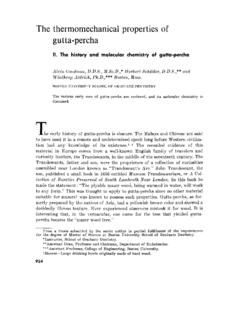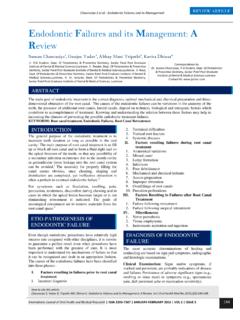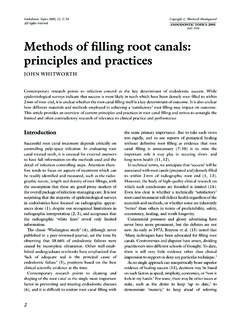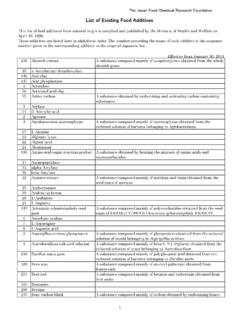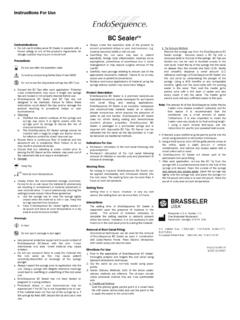Transcription of Gutta Percha Points - DiaDent Group International
1 Gutta Percha Points Safety Data Sheet Page 1 of 5. 1. Product & Company Identification A. Product Name Gutta Percha Points B. Purpose of Use & Restrictions on Use Purpose of Use Filling root canals Restrictions on Use For dental professionals only C. Company Information Company Name DiaDent Group International Address 16 Osongsaengmyeong 4-ro, Osong-eup, Heungdeok-gu, Cheongju-si, Chungcheongbuk-do, Republic of Korea 28161. Emergency Contact Number 82-43-266-2315. 2. Hazard Identification A. GHS Classification Serious Eye Damage/Eye Irritation: Category 2. Specific Target Organ Toxicity (Single Exposure): Category 3, Respiratory System B. GHS Label elements, including precautionary statements Pictograms Signal Words Caution Hazard Statement(s) H319 Causes severe eye irritation Precautionary Statement(s).
2 Prevention P264 Wash hands thoroughly after handling the product. P280 Wear protective gloves/protective clothing/eye protection/face protection. Response P304 + P340 IF INHALED: Remove victim to fresh air and keep at rest in a position comfortable for breathing. P305 + P351 + P338 IF IN EYES: Rinse cautiously with water for several minutes. Remove contact lenses, if present and easy to do. Continue rinsing. P312 Call a POISON CENTER or doctor/physician if you feel unwell. P337 + P313 If eye irritation persists: Get medical advice/attention. Page 2 of 5. Storage P403 + P233 Store in a well-ventilated place. Keep container tightly closed. Disposal P501 Dispose of contents/container according to the related regulations.
3 C. Other hazards (according to the NFPA Rating System). Health 1. Fire 1. Reactivity 0. 3. Composition & Information on Ingredients Chemical Identity Common Name CAS No. % Volume ZINC OXIDE ZINC WHITE 1314-13-2 66. BaSO4 SULFURIC ACID, BARIUM SALT (1:1) 7727-43-7 11. Stearic Acid 1-HEPTADECANECARBOXYLIC ACID 57-11-4 3. Gutta Percha - - 20. 4. First Aid Measures A. Eyes Get medical aid immediately if discomfort or irritation persists. B. Skin Consult a physician immediately if you feel discomfort. C. Inhalation Remove patient from exposure to fresh air immediately. Administer approved oxygen supply if breathing is difficult and get medical aid immediately. D. Ingestion Seek immediate medical help. E. Notes to Physicians Have a comprehensive understanding on the chemical and treat symptomatically.
4 5. Firefighting Measures A. Appropriate Extinguishing Media To extinguish a fire caused by or related to this chemical, use alcohol-resistant foam, Carbon Dioxide (CO2), or water spray. Use dry sand or soil to smother the fire. B. Specific hazard arising from the chemical Smoke (fumes) can be produced due to pyrolysis or combustion process. C. Special Protective Equipment & Precautions for Firefighters Fire-fighters should wear appropriate protective equipment. Stay a safe distance away from the fire while extinguishing. If not dangerous, remove the container from the fire. To dispose of fire water, pour it into a spacious dug lot and make sure it is not spilled or scattered outward. If not dangerous, remove the container from the fire.
5 Page 3 of 5. 6. Accidental Release Measures A. Protective equipment & Emergency procedures Give special attention to chemical materials and conditions that must be avoided. B. Environmental precautions Prevent the inflow of this product to waterways, drains, basements, and confined spaces. C. Purification / Removal Method Dispose of the product as medical waste. 7. Handling & Storage A. Safe handling Follow all prevention measures on the SDS/labels. Handle and store with care. Give special attention to chemical materials and conditions that must be avoided. Wear personal protective equipment while handing the product. B. Conditions for Safe Storage Keep away from humidity. 8. Exposure control & Personal protection A.
6 Exposure Limits for Chemical Substances & Biological Exposure Limits N/A. B. System Design (Proper Engineering Controls) N/A. C. Personal protective equipment Respiratory protection N/A. Eye protection N/A. Hand protection N/A. Skin & body protection N/A. 9. Physical & Chemical Properties A. Appearance Physical state Solid (conical shape). Color Pink B. Odor N/A. C. Odor threshold value N/A. D. pH N/A. E. Melting point/Freezing point N/A. F. Initial boiling point & Boiling range N/A. G. Flash point N/A. H. Evaporation rate N/A. I. Flammability (solid, gas) N/A. J. Maximum / minimum of the flammable or explosive limits N/A. K. Vapor pressure N/A. L. Solubility 100 . M. Vapor density N/A. N. Relative density g/.
7 O. Partition coefficient: n-Octanol/water N/A. P. Autoignition temperature N/A. Q. Decomposition temperature N/A. R. Viscosity N/A. S. Molecular mass N/A. Page 4 of 5. 10. Stability & Reactivity A. Chemical stability & Possibility of hazardous reactions N/A. B. Conditions to avoid Direct light, excessive heat, and moisture C. Incompatible materials Inflammable Materials & Reducing Materials D. Hazardous decomposition or byproduct Smoke (fumes) can be produced due to pyrolysis or combustion process. 11. Toxicological Information A. Possible routes of exposure N/A. B. Information on harmful health effects (Symptoms related to the physical, chemical and toxicological characteristics). Acute toxicity Oral N/A.
8 Dermal N/A. Inhalation N/A. Skin corrosion/Irritation N/A. Serious Eyes damage/Irritation May cause irritation to the eyes Respiratory sensitization N/A. Skin sensitization N/A. Carcinogenicity Industrial Safety and Health Act N/A. Notification of the Ministry of Employment and Labor N/A. IARC N/A. OSHA N/A. ACGIH N/A. NTP N/A. EU CLP N/A. Germ cell mutagenicity N/A. Reproductive Toxicity N/A. Specific Target Organ Toxicity (Single Exposure) Inhalation causes respiratory tract irritation Specific Target Organ Toxicity (Repeated Exposure) N/A. Aspiration Toxicity N/A. 12. Ecological information A. Ecotoxicity Fish N/A. Shellfish N/A. Birds N/A. B. Persistence & Degradability Persistence N/A. Degradability N/A.
9 C. Bioaccumulative potential Accumulation N/A. Biodegradability N/A. D. Mobility in soil N/A. E. Other adverse effects N/A. Page 5 of 5. 13. Disposal Considerations A. Product Disposal If stated in the Wastes Control Act, dispose of the contents and container accordingly. B. Precautions for Disposal Dispose of the content according to the related regulations. 14. Transport Information A. UN No. Classification information on transportation of hazardous materials not available B. Proper shipping name N/A. C. Hazard class N/A. D. Packing Group N/A. E. Marine pollutant N/A. F. Any special precautions which an user should be aware of or needs to comply with, in connection with transport or conveyance either within or outside their premises (Special precautions which a user needs to be aware of or needs to comply outside their premises with in connection with transport or conveyance either within or outside their premises).
10 Emergency procedures in case of fire N/A. Emergency procedures in case of spill/leak N/A. 15. Regulatory Information A. Regulations according to the Industrial Safety and Health Act N/A. B. Regulations according to the Toxic Chemicals Control Act N/A. C. Regulations according to the Safety Control of Dangerous Substances Act N/A. D. Regulations according to the Wastes Control Act N/A. E. Other regulations according to domestic and foreign laws - Follow the regulations of the KFDA (Korea Food & Drug Administration). - Follow the regulations of the Directive 93/42/EEC and 2007/42/EC. 16. Other Information ( Other information including information on preparation and revision of the SDS ). A. Source of Data International Uniform Chemical Information Database (IUCLID).

